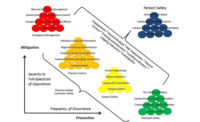Winning hearts and minds: A different kind of war

Over the past 15 years in safety, the phrase “winning hearts and minds” has been used in presentations at conferences worldwide. There is agreement that the best safety cultures come when everyone involved takes ownership for safety and is empowered to develop, communicate and use the safest possible work conditions and practices, all tenets of transformational leadership (Rehman & Waheed, 2012).
There is agreement that the best safety cultures come when hierarchal directives and transactional chores are replaced with mutual respect, lateral communication and acknowledgment of expertise regardless of position, all tenets of servant leadership (Dierendonck, 2011) and high-reliability principles (Boin & Schulman, 2008). There is agreement that one leadership style cannot be sufficient for all the dynamics in a workplace or society, so contingency (Hanisch & Wald, 2012) and situational leadership (Hersey & Blanchard, 1987) are good. There is agreement that operations must continue with as little disruption as possible and that safety should assist them, not impair them.
All these factors and more add up to the proverbial “winning hearts and minds,” a concept that is supposed to make team members want to be safe. But, how does someone win hearts and minds? There is no guide. There is no checklist. However, the phrase “winning hearts and minds” came from something diametrically opposed to safety: war. If the objective of a war is to literally kill the opposition, what did “hearts and minds” have to do with it? As it turns out, quite a bit.

Source: Killcullen, 2006
The origins of ‘winning hearts and minds’
In military operations, armies began terrorizing local populations in areas they sought to invade in efforts to force the population to submit to their rule and deny access or assistance to their opposition (Kilcullen, 2009). These armies, known as ‘insurgents,’ moved into areas, blended in with the population and committed acts of violence so that the population would be forced to do their bidding – and sometimes be eventually rewarded for it – or continue being harmed or killed. The opposition, the ‘counterinsurgency,’ inherited the task of determining who in the population was part of the insurgency and removing them to stop them violence. However, with the insurgency blended in with the population, the counterinsurgent had to incentivize the local population to help them find the insurgency, often putting them in peril of being hurt or killed for helping the counterinsurgency.
This incentivizing became known as “winning hearts and minds.” Counterinsurgency Theory, developed by many including David Galula (1964), Dr. David Kilcullen and more but operationally traced back to T.E. Lawrence – ‘Lawrence of Arabia’ - during World War I (Lawrence, 1926), became defined as “competition with the insurgent for the right to win the hearts, minds, and acquiescence of the population” (Kilcullen, 2006, p. 134). In turn, counterinsurgents from World I to World War II to Vietnam to Afghanistan to Iraq to Syria and more have sought to identify insurgents in war-stricken areas; live amongst the population; provide them with food, water and other necessities along with training, weapons and other needs for self-defense and healthcare, schools and other services to help them; identify the patterns and evidence of the insurgency and, when located and after ensuring they knew who the insurgency was, remove them, by force if necessary (Gant, 2009). Differing from ‘direct-fire’ combat, most recognizable in events such as the D-Day Normandy invasions (Winters & Kingseed, 2006), counterinsurgencies have more to do with living among the population and empowering them rather than killing, something only done when the insurgency has been identified and continued to do harm (Gant, 2009).

Source: Cory Worden
Insurgents and counterinsurgents
In a simple example of a counterinsurgency to “win hearts and minds,” an insurgency would have moved into an area and began harming the population to join their cause. The counterinsurgent would have also moved in among the population and sought to locate the insurgent. To do this, the counterinsurgent would have provided the local population necessities such as food and water along with training and weapons to empower them for internal defense. Also provided would be schools, healthcare and other needs so that the population would see the benefits of assisting the counterinsurgent, even at their own risk. The counterinsurgent will continue to promote the cause of peace and freedom while looking for signs of the insurgency.
Finally, if the insurgency does not leave and has proven that they will continue to do harm, the counterinsurgent will move to ‘direct action’ and forcibly remove them (Kilcullen, 2010). Ultimately, within any population, there will be a portion of the population that sides with the insurgency; regardless of what information and assistance is provided, they’ll continue to do harm (Kilcullen, 2006). These are the ‘defiantly unsafe’ (Worden, 2015). On the other end of the spectrum, there is a portion of the population that will always be safe. These are the “definitely safe.”
However, there is also a larger portion in the middle of the spectrum that won’t decide on being safe or not. They’ll simply wait to see what the rest of the population does; if the population promotes safety, they’ll do it. If the population disavows safety, they’ll go with that (Kilcullen, 2006). The trick is to continually win hearts and minds so that these ‘subject to the local culture’ will see that the local culture supports safety (Worden, 2015).

Source: Cory Worden
Counterinsurgency against unsafe practices
As it is shown, “counterinsurgency” is a matter of determining where and how unsafe practices – in the case of war, violence to others – has become imbedded in a population and has begun hurting it.
If this concept of “winning hearts and minds” has worked in wars to locate and remove physical insurgents harming others, how would we use it in a hospital to achieve high-reliability (Worden, 2014)? First, the players must be identified. In the case of safety, there is no “enemy.” Instead, the “insurgent” – the thing causing harm – is a set of unsafe states of mind that have “invaded” the workplace. These “insurgents” – often-subconscious mindsets such as rushing, fatigue, frustration, complacency (Wilson & Higbee, 2012), distractions, burnout or others along with working conditions such as short-staffing, combative patients and others – have become part of the workplace and employees, should they seek to work against them, fear they’ll be accused of not being committed, being reprimanded or other negative outcomes.
With this, when safety, the “counterinsurgent,” begins trying to figure out how and why incidents such as slips, trips, falls, patient handling incidents, strains, workplace violence, bloodborne pathogen exposures and more keep occurring, safety has to first figure out where these “insurgents” are hiding. Safety has to “win hearts and minds” of the employee population so that they’ll want to work safety. Safety talks with the teams about the hazards and where and how they exist.
With this, safety helps to provide the necessities to work safely – hazard controls such as equipment, procedures, PPE, training, education and other necessities including communication between the employee population and the executive leadership as an advocate for employee safety through Safety Committees and other functions. Furthermore, safety provides consistent and recurring communication regarding safety bulletins, training reminders and other notes to keep it on everyone’s mind. At this point, with hazards being identified and discussed and leadership teams providing necessities for safe work and the safe work conditions and practices being communicated, Safety helps to validate that safe work is happening through observations, inspections, near-miss follow-ups and more. Incidents are tracked and investigated.
At this point, efforts have been directed at “winning hearts and minds” so that team members can root out the “insurgents” of unsafe practices and patterns such as rushing, fatigue, frustration, distractions, lacks of situational awareness and more. However, if these still show up on investigations and during observations and other indicators, preventative measures can be directed at removing them.
If they still show up after due diligence has been paid to preventing them, now “direct action” can be applied through Human Resources accountability processes. The intention is never to punish anyone; the intention is do everything possible to build safe work practices. However, if the “insurgents” remain by choice, the situation becomes a matter of performance accountability (Worden, 2015).
Conclusion
Ultimately, by tracing back Counterinsurgency Theory (Galula, 1964) and its applications over the past century, the phrase “winning hearts and minds” is expounded upon. There are notable processes used to not only gain the favor of a population but to do so in the face of a diametric force that is holding it hostage (Kilcullen, 2010). So, for the population to choose the counterinsurgent’s cause against the insurgent’s in the face of unfavorable consequences, the counterinsurgent must provide very favorable incentives and also stand up to the insurgent (Gant, 2009). Only then will those “subject to local culture” begin to be willing to go against the insurgent.
This same concept applies whether the insurgent is a man with a weapon making threats or an unsafe pattern like rushing through tasks currently viewed as the way to “get things done.” When one goes against this unfortunately accepted norm, he or she risks an unfavorable reaction, whether it’s a physical threat or reprisal for “working too slowly.”
However, when “hearts and minds” are won through the incentives of a safer existence, the population becomes willing to go against this possible reprisal because the outcome – a safer life – is worth it. This, in turn, changes the culture and those “subject to local cultures” will shift to the “definitely safe” side. Then, the insurgency is pushed out and the culture changes. It’s not an easy thing to do, but it’s not an enigma and, with engagement and participation, it’s achievable (Worden, 2015).
References
1. Boin, A. & Shulman, P. (2008). Assessing NASA’s safety culture: The limits and possibilities of high-reliability theory. Public Administration Review. 68(6), 1050-1062.
2. Dierendonck, D.V. (2011). Servant leadership: A review and synthesis. Journal of Management, 37(4), 1228-1261.
3. Galula, D. (1964). Counterinsurgency warfare: Theory and practice. Westport, CT: Praegar Security International.
4. Gant, J. (2009). One tribe at a time: The paper that changed the war in Afghanistan. New York, NY: Black Irish Entertainment.
5. Hanisch, B. & Wald, A. (2012). A bibliometric view on the use of contingency theory in project management research. Project Management Journal, 43(3), 4-23.
6. Hersey, P., & Blanchard, K. H. (1969). Life cycle theory of leadership. Training and Development Journal, 23(2), 26-34.
7. Kilcullen, D. (2006, October). 28 Articles: Fundamentals of company-level counterinsurgency. Military Review, 134-139.
8. Kilcullen, D. (2009). The accidental guerrilla. New York, NY: Oxford University Press.
9. Kilcullen, D. (2010). Counterinsurgency. New York, NY: Oxford University Press.
10. Lawrence, T.E. (1926). Seven pillars of wisdom. New York, NY: Anchor Books.
11. Rehman, R.R., & Waheed, A. (2012). Transformational leadership style as predictor of decision- making styles: Moderating role of emotional intelligence. Pakistan Journal of Commerce & Social Sciences, 6(2), 257-268.
12. Wilson, L. & Higbee, G. (2012). Inside out: Rethinking traditional safety management paradigms. Belleville, Ontario: Electrolab Limited.
13. Winters, D. & Kingseed, C.C. (2006). Beyond Band of Brothers: The war memoirs of Major Dick Winters. New York, NY: Berkley.
14. Worden, C. (2015). Culture change: Winning hearts and minds for safety. Texas City, TX: College of the Mainland.
15. Worden, C. (2014). High-reliability safety program development. AOHP Journal, 34(4), 13-14.
16. Worden, C. (2016). Perceptions: The importance of employee engagement in safety. AOHP Journal, 36(2), 14.
Looking for a reprint of this article?
From high-res PDFs to custom plaques, order your copy today!








